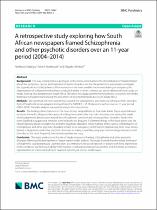| dc.contributor.author | Masinga, Nombuso | |
| dc.contributor.author | Nyamaruze, Patrick | |
| dc.contributor.author | Akintola, Olagoke | |
| dc.date.accessioned | 2022-12-05T11:01:21Z | |
| dc.date.available | 2022-12-05T11:01:21Z | |
| dc.date.issued | 2022 | |
| dc.identifier.citation | Masinga, N., et al. (2022) A retrospective study exploring how South African newspapers framed Schizophrenia and other psychotic disorders over an 11-year period (2004–2014). BMC Psychiatry 22-667. DOI: https://doi.org/10.1186/s12888-022-04276-5 | en_US |
| dc.identifier.issn | 1471244X | |
| dc.identifier.uri | https://doi.org/10.1186/s12888-022-04276-5 | |
| dc.identifier.uri | http://hdl.handle.net/10566/8250 | |
| dc.description.abstract | Background: The way schizophrenia is portrayed in the media contributes to the dissemination of misinformation
about the symptoms, causes, and treatment of mental disorders and has the potential to perpetuate or mitigate
the stigmatization of schizophrenia. While research on the news media’s role in exacerbating or mitigating the
stigmatization of schizophrenia has been conducted widely in other contexts, our search did not yield any study on
media framing of schizophrenia in South Africa. Therefore, this study used the framing theory to examine the media
framing of schizophrenia following the enactment of two mental health policies in South Africa.
Methods: We examined 216 news stories that covered the schizophrenia spectrum and other psychotic disorders
from 20 South African newspapers retrieved from the SABINET – SA Media online archive over an 11-year period
(2004–2014). Thematic analysis was used to analyse the news stories.
Results: The findings show that most of the news stories had problems as their main frame. These were followed
by stories framed to diagnose the causes of schizophrenia and other psychotic disorders; and stories that made
moral judgements about issues around the schizophrenia spectrum and other psychotic disorders. Stories that
were classified as suggesting remedies were relatively less frequent. A common thread in the news stories was the
misperceptions about schizophrenia and other psychotic disorders. Media framing of the cultural interpretations of
schizophrenia and other psychotic disorders tended to be derogatory and therefore stigmatising. Most news stories
framed schizophrenia and other psychotic disorders as mainly caused by using psychoactive drugs/substance with
Cannabis as the most frequently mentioned psychoactive drug.
Conclusion: The study underscores the role of media analyses in framing schizophrenia and other psychotic
disorders following the development of major mental health policies. The study showed that the media framing of
schizophrenia could perpetuate stigmatisation, discrimination and social rejection of people with lived experiences
of the condition. Our findings highlight the need for collaboration between researchers and the media to enhance
opportunities for improved and more nuanced reporting of mental health issues. | en_US |
| dc.language.iso | en | en_US |
| dc.publisher | BMC | en_US |
| dc.subject | Psychiatry | en_US |
| dc.subject | Schizophrenia | en_US |
| dc.subject | Non-communicable diseases | en_US |
| dc.subject | Mental health care | en_US |
| dc.subject | South Africa | en_US |
| dc.subject | Newspapers | en_US |
| dc.title | A retrospective study exploring how South African newspapers framed Schizophrenia and other psychotic disorders over an 11-year period (2004–2014) | en_US |
| dc.type | Article | en_US |

